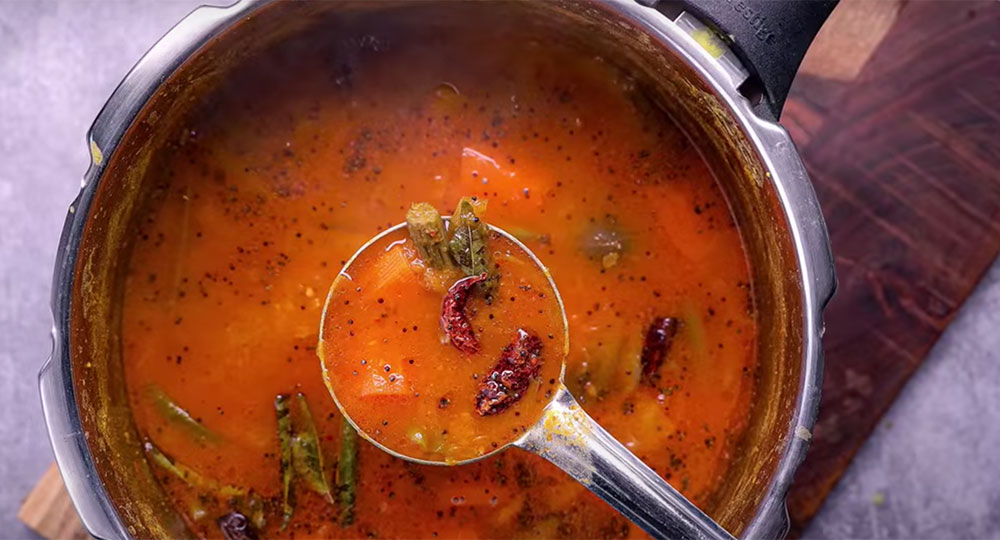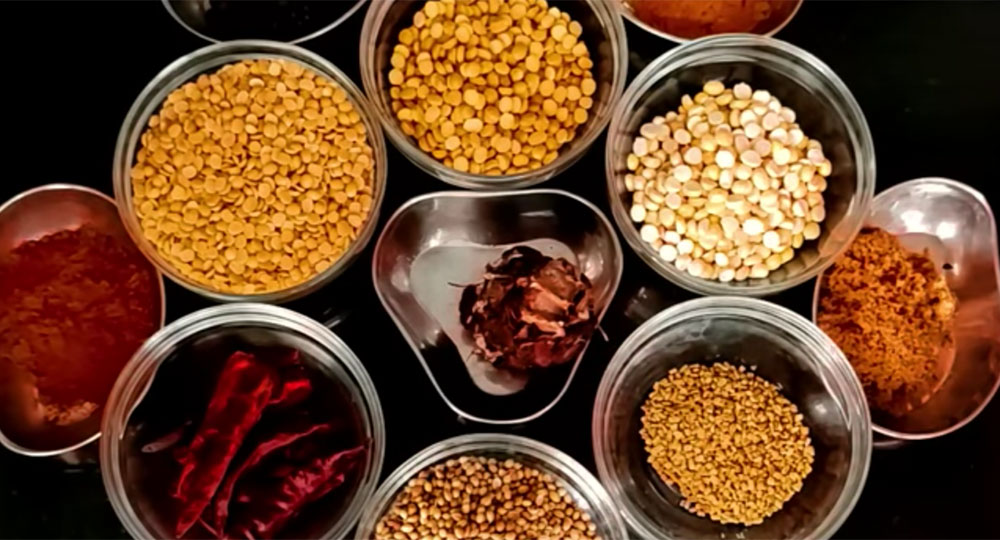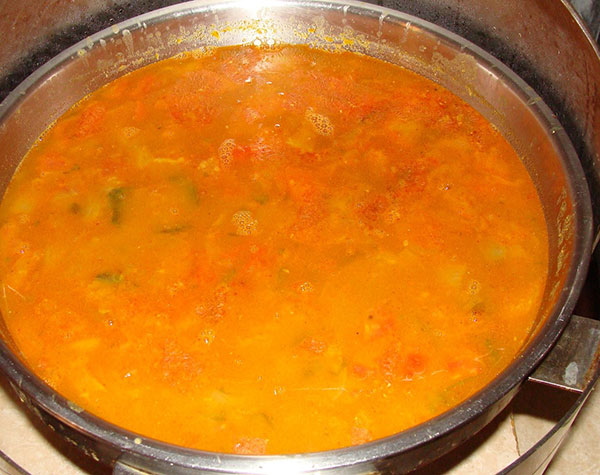
Discover the Flavor of Chakalaka: A Vibrant Vegetarian Meal from South Africa
August 12, 2024
Japanese Vegetarian Ramen
August 16, 2024
Discover the Flavor of Chakalaka: A Vibrant Vegetarian Meal from South Africa
August 12, 2024
Japanese Vegetarian Ramen
August 16, 2024
Sambar
Sambar, a quintessential dish in South Indian cuisine, is more than just a food item; it is a cultural symbol, embodying the flavors, traditions, and history of the region. This hearty lentil-based stew, flavored with a unique blend of spices and enriched with a variety of vegetables, has become a staple not only in South India but also across the Indian subcontinent and among Indian communities worldwide. The dish is celebrated for its simplicity, versatility, and the nutritional value it offers.
20 Mins
Easy
Serves 6
Origins and Historical Significance
The origins of sambar are steeped in legend and tradition. Some culinary historians trace its roots back to the Maratha ruler, Shahuji, who, in the 17th century, allegedly created the dish in the royal kitchens of Thanjavur, Tamil Nadu, while attempting to prepare a dal dish with tamarind, a key ingredient in sambar. This accidental creation became an instant favorite, and over time, the dish evolved into what we now know as sambar.
Sambar is deeply intertwined with the culinary traditions of South India, particularly in the states of Tamil Nadu, Karnataka, Kerala, and Andhra Pradesh. It has become an integral part of the daily diet in these regions, often served with rice, idli (steamed rice cakes), dosa (a type of pancake made from fermented rice and lentils), or vada (fried lentil doughnuts). The dish is not just food; it is a reflection of the local agricultural practices, as it utilizes locally grown lentils, vegetables, and spices.
Ingredients and Preparation
At the heart of sambar is the humble lentil, typically toor dal (pigeon peas), which provides a protein-rich base. The lentils are cooked until they are soft and then blended into a smooth consistency. The choice of vegetables varies, but commonly used ones include drumsticks (moringa), carrots, pumpkins, okra, eggplant, and tomatoes. These vegetables not only add nutritional value but also contribute to the dish's complex texture and flavor.
The tangy taste that defines sambar comes from tamarind, a souring agent that is ubiquitous in South Indian cooking. Tamarind pulp is soaked and then added to the cooking vegetables, infusing the dish with its distinctive tanginess. The spice blend, known as sambar powder, is what sets sambar apart from other lentil-based stews. This powder typically includes a mixture of coriander seeds, dried red chilies, fenugreek seeds, cumin seeds, and sometimes coconut, all of which are roasted and ground into a fine powder. This spice mix is crucial in imparting the deep, earthy flavors that sambar is known for.
The final touch in sambar preparation is the tempering or tadka. Mustard seeds, curry leaves, dried red chilies, and asafoetida (hing) are fried in oil or ghee until they crackle and release their aromas. This tempering is poured over the sambar, adding a burst of flavor and aroma that elevates the dish to new heights.

Nutritional Value and Cultural Significance
Sambar is not only a flavorful dish but also a highly nutritious one. Lentils are a rich source of protein, making sambar an essential part of the diet, especially in vegetarian households. The inclusion of a variety of vegetables ensures that the dish is packed with vitamins, minerals, and dietary fiber. The spices used in sambar, particularly turmeric and cumin, are known for their anti-inflammatory and digestive properties, adding to the dish's health benefits.
Culturally, sambar holds a special place in South Indian households. It is a dish that is prepared daily, yet it is also served during special occasions, festivals, and celebrations. The versatility of sambar allows it to be adapted to different occasions and personal preferences. For instance, in Tamil Nadu, sambar is often thinner and more tangy, while in Karnataka, it tends to be thicker and slightly sweeter, reflecting the regional differences in taste and preparation.
Sambar is also a symbol of hospitality in South India. A typical South Indian meal, served on a banana leaf, is incomplete without sambar. The act of serving sambar, especially in generous portions, is seen as a gesture of warmth and welcome.
Global Influence and Adaptations
As South Indian communities have spread across the globe, sambar has traveled with them, finding a place in kitchens far beyond the subcontinent. In many Western countries, sambar is a popular dish in Indian restaurants, often served as part of a traditional South Indian thali (a platter with a variety of dishes). It has also been adapted to suit local tastes, with variations that include different types of lentils or vegetables that are more readily available in those regions.
The global popularity of sambar is a testament to its universal appeal. It is a dish that resonates with people not just because of its flavors but also because of the comfort it brings. Whether it is enjoyed as part of a simple meal at home or as a delicacy in a restaurant, sambar continues to be a beloved dish that connects people to the rich culinary heritage of South India.
Conclusion
Sambar is much more than just a stew; it is a representation of South India's rich culinary tradition, a dish that has stood the test of time and continues to be cherished by millions. Its unique combination of flavors, textures, and nutritional benefits makes it a dish that is as wholesome as it is delicious. In every spoonful of sambar, one can taste the history, culture, and the soul of South Indian cuisine.
How to cook Sambar?
Cooking sambar at home is a delightful process that brings together the rich flavors of lentils, vegetables, and spices. Here's a step-by-step guide to making traditional South Indian sambar:
Ingredients:
For the Sambar:
- Toor dal (pigeon peas): 1/2 cup
- Turmeric powder: 1/4 teaspoon
- Tamarind: 1 small lemon-sized ball (soaked in warm water)
- Mixed vegetables (drumsticks, carrots, potatoes, pumpkin, okra, tomatoes, eggplant, etc.): 1-2 cups, chopped
- Sambar powder: 2 tablespoons
- Salt: to taste
- Water: as needed
- Jaggery (optional): 1 teaspoon
For the Tempering (Tadka):
- Oil or ghee: 2 tablespoons
- Mustard seeds: 1 teaspoon
- Cumin seeds: 1/2 teaspoon
- Dried red chilies: 2, broken
- Curry leaves: 8-10 leaves
- Asafoetida (hing): a pinch
Preparation Steps:
1. Cook the Lentils:
- Wash the toor dal thoroughly under running water.
- In a pressure cooker, add the washed dal, turmeric powder, and about 2 cups of water.
- Cook the dal on medium heat for 4-5 whistles or until it becomes soft and mushy. If you're using a pot, cook until the dal is very soft, which may take about 30-40 minutes.
- Once cooked, mash the dal well with the back of a spoon and set it aside.
2. Prepare Tamarind Extract:
- While the dal is cooking, soak the tamarind in warm water for about 10-15 minutes.
- Squeeze the tamarind well to extract the juice and strain out the pulp. Set the tamarind juice aside.
3. Cook the Vegetables:
- In a large pot, add the chopped vegetables, tamarind juice, and a pinch of turmeric powder.
- Add enough water to cover the vegetables and bring it to a boil.
- Reduce the heat and let the vegetables cook until they are tender but not mushy. This should take about 10-15 minutes.
4. Combine the Dal and Vegetables:
- Once the vegetables are cooked, add the mashed dal to the pot.
- Add sambar powder and salt to taste. Mix everything well.
- Let the sambar simmer on low heat for about 10 minutes, allowing the flavors to meld together. If the sambar is too thick, add a little water to achieve the desired consistency.
- Optionally, add jaggery for a hint of sweetness and balance of flavors. Simmer for another 2-3 minutes.
5. Prepare the Tempering (Tadka):
- In a small pan, heat oil or ghee over medium heat.
- Add mustard seeds and let them splutter.
- Add cumin seeds, dried red chilies, and curry leaves. Fry them for a few seconds until aromatic.
- Add a pinch of asafoetida (hing) and stir well.
- Pour this tempering over the simmering sambar and mix it well.
6. Final Touches:
- Let the sambar simmer for another 2 minutes to allow the tempering flavors to blend.
- Turn off the heat and cover the pot. Let the sambar sit for a few minutes before serving.
Serving Suggestions:
- Serve hot sambar with steamed rice, idli, dosa, or vada.
- Accompany it with a dollop of ghee for extra richness and flavor.
- You can garnish the sambar with fresh coriander leaves for added freshness.
Tips:
- Sambar Powder: If you don't have store-bought sambar powder, you can make a quick version at home by roasting and grinding coriander seeds, dried red chilies, cumin seeds, fenugreek seeds, and a little turmeric.
- Consistency: Adjust the consistency of sambar to your liking by adding more or less water. It should be slightly thick but pourable.
- Vegetables: You can use any combination of vegetables you prefer or have on hand. Each adds a unique flavor and texture to the sambar.
Enjoy your homemade sambar with your favorite South Indian dishes!

